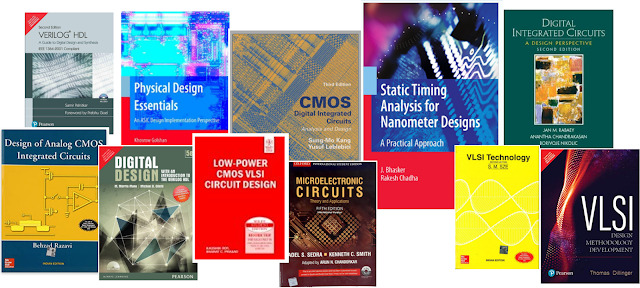In the previous article, Best 5 books have recommended for Physical Design Engineer. While writing that article it was very difficult to make many books out of the list. So I thought it will be better to write another article on the best 25 books for VLSI Design. This list starts from the basic level of books to the advance level of books. I have categories these books into 8 major categories.
If you wish you buy any books, I have searched the bestseller, best edition and best price of these books and linked here. You can buy these books from these links through amazon.
I. Basic Digital Electronics
1. Electronic Devices And Circuits Theory by Robert L. Boylestad
The main content of this book is as follow:
- Semiconductor Diodes
- Diode applications
- Bipolar Junction Transistor
- DC Biasing – BJT
- BJT AC Analysis
- Field-Effect Transistors
- FET Biasing
- FET amplifier
- BJT and JFET Frequency response
- Operational Amplifiers
- OP-Amp applications
- Power Amplifiers
- Linear Digital ICs
- Feedback and Oscillator Circuits
- Power Supply (Voltage Regulators)
- Other Two Terminals Devices
- PNPN and other devices
2. Digital Design with an Introduction to the Verilog HDL by M. Morris Mano
- Binary Systems
- Boolean Algebra and Logic Gates
- Simplification of Boolean Functions
- Combinational Logic
- MSI and PLD Components
- Synchronous Sequential Logic
- Registers, Counters and The Memory Units
- Algorithm State Machines (ASM)
- Asynchronous Sequential Logic
- Digital Integrated Circuits
- Laboratory Experiments
- Standard Graphics Symbols
II. Verilog HDL and SystemVerilog
3. Verilog HDL by Samir Palnitkar
The main content of this book is as follow:
1 Overview of Digital Design with Verilog HDL2 Hierarchical Modeling Concepts3 Basic Concepts4 Modules and Ports5 Gate-Level Modeling6 Dataflow Modeling7 Behavioral Modeling8 Tasks and Functions9 Useful Modeling Techniques10 Timing and Delays11 Switch-Level Modeling12 User-Defined Primitives13 Programming Language Interface14 Logic Synthesis with Verilog HDL
4. FPGA Prototyping by Verilog Examples by Pong P. Chu
-
Gate-Level Combinational Circuits
-
Overview of FPGA and EDA software
-
RTL combinational circuit
-
Regular Sequential Circuit
-
FSM
-
FSMD
-
Selected Topics of Verilog
-
UART
-
PS2 Keyboard
-
PS2 Mouse
-
External SRAM
-
Xilinx Spartan-3 Specific Memory
-
VGA Controller -1: Graphics
-
VGA Controller-II: Text
-
PicoBlaze Overview
-
PicoBlaze Assembly Code Development
-
PicoBlaze I/O Interface
-
PicoBlaze Interrupt Interface
-
Simple Verilog Templates
5. SystemVerilog for Verification by Chris Spear
- Verification Guidelines
- Data Types Procedural Statements and Routines
- Connecting the Testbench and Design
- Basic OOP
- Randomization Threads and Interprocess Communication
- Advanced OOP and Testbench Guidelines
- Functional Coverage
- Advanced Interfaces
- A Complete SystemVerilog Testbench
- Interfacing with C/C++
III. Semiconductor Devices
6. Solid State Electronic Devices by Streetman and Banerjee
IV. Fabrication Technologies
9. The Science and Engineering of Microelectronic Fabrication by Stephen A Campbell
9.a. Fundamental of Semiconductor Fabrication by S M SZE
The main content of this book is as follow:
- Introduction
- Crystal Growth
- Silicon Oxidation
- Photolithography
- Etching
- Diffusion
- Ion Implantation
- Film Deposition
- Process Integration
- IC Manufacturing
- Future Trends and Challenges
- Introduction
- Crystal Growth
- Silicon Oxidation
- Photolithography
- Etching
- Diffusion
- Ion Implantation
- Film Deposition
- Process Integration
- IC Manufacturing
- Future Trends and Challenges
V. Analog Design
10. Design of Analog CMOS Integrated Circuits by Behzad Razavi
11. Microelectronic Circuit Theory and Application by Sedra and Smith
VI. Digital Design
13. CMOS Digital Integrated Circuit by Sung-Mo Kang and Yusuf Leblebici
VII. Low Power Design
16. Low Power CMOS VLSI Circuit Design by Kaushik Roy
VIII. Advance Books
18. Static Timing Analysis For Nanometer Design by J Bhaskar
The main content of this book is as follow:
- CHAPTER 1: Introduction
- CHAPTER 2: STA Concepts
- CHAPTER 3: Standard Cell Library
- CHAPTER 4: Interconnect Parasitics
- CHAPTER 5: Delay Calculation
- CHAPTER 6: Crosstalk and Noise
- CHAPTER 7: Configuring the STA Environment
- CHAPTER 8: Timing Verification
- CHAPTER 9: Interface Analysis
- CHAPTER 10: Robust Verification
19. Constraining Design for Synthesis and Timing Analysis by Sridhar Gangadharan
- ASIC DESIGN METHODOLOGY TUTORIAL
- BASIC CONCEPTS
- SYNOPSYS TECHNOLOGY LIBRARY
- PARTITIONING AND CODING STYLES
- CONSTRAINING DESIGNS
- OPTIMIZING DESIGNS
- DESIGN FOR TEST
- LINKS TO LAYOUT & POST LAYOUT OPT
- PHYSICAL SYNTHESIS
- SDF GENERATION
- PRIMETIME BASICS
- STATIC TIMING ANALYSIS
21. Physical Design Essentials by Khosrow Golshan
The main content of this book is as follow:
1.1 Standard Cells 1.4 Library Characterization
2.1 Technology File 2.3 Design Constraints
2.4 Design Planning2.5 Pad Placement2.6 Power Planning2.7 Macro Placement
3.1 Global Placement 3.2 Detail Placement
3.3 Clock Tree Synthesis3.4 Power Analysis
4.1 Special Routing
4.2 Global Routing4.3 Detail Routing4.4 Extraction
5.1 Functional Verification 5.2 Timing Verification
5.3 Physical Verification
6.1 Functional Test6.2 Scan Test 6.3 Boundary Scan Test6.4 Fault Detection6.5 Parametric Test6.8 Memory Test




























This was really helpful! Thanks a lot 😊
wowww
thank you
Thanks Sai!!!